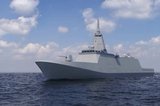UK Royal Navy begins training with autonomous mine counter measures vessel
The Thales USV on delivery to the UK RN. (Photo: UK MoD/Crown copyright)
The UK’s RN has deployed an autonomous mine countermeasure (MCM) system for the first time.
The new capability consisted of a USV, the RN Motor Boat (RNMB) Ariadne, some off-board payloads and a remote command centre (RCC).
The technology will allow the RN to detect mines with greater safety to human life, and at far less expense than crewed MCM vessels.
Related Articles
Oostende mine countermeasures vessel begins sea trials
Swedish Navy and Saab sign deal on autonomous mine countermeasures vessels
New anti-mine technology delivered to French and Royal Norwegian navies
The deployment was the first UK use of a collaborative technological programme between France and the UK, and using technology from Thales. France made its first deployment of the system in February.
Under the agreement, the French Navy will receive and deploy six USVs in 2025, as three systems-of-systems, each comprising two USVs, alongside the prototype system already delivered.
The RN will receive four systems-of-systems, each comprising just a single USV, during the course of 2025, of which the currently deployed system is the first.
The USV, along with its fellows in both UK and French deployments, is 12m long, a significant length in that the vessels have been designed to be used on France’s future Mine Warfare Vessel (BGDM). The BGDM in turn are expected to be based on the minesweeper vessels being built for the Belgian and Dutch navies under their rMCM programme.
The vessel can be deployed from either a harbour or a mothership, using the Thales towed synthetic aperture multi-views (TSAM) system, which is a new and sophisticated sonar.
The UK’s investment in Thales’ system amounts to £184 million (almost US$240 million), while the total contract value across the UK and France is £363 million.
Minister for Defence Procurement and Industry Maria Eagle said: “This delivery marks a significant milestone in our mine-hunting capabilities and the autonomous technology will keep Britain and our Royal Navy sailors safer by identifying and removing mines.”
Jonathan Reed-Beviere, programme director of the mine hunting capability programme within the RN, added that the delivery was “fundamental to the Royal Navy’s ambition to embrace maritime autonomous systems,.
"As the first Degree 3 autonomous vessel to be delivered into the hands of our sailors, [this furthers] our dedication to removing personnel from the danger of operating within a minefield.”
Degree 3 autonomy is essentially full self-driving, but with an operator permanently present should the need arise. It represents a significant step away from fully human-crewed minesweepers.
Related Programmes in Defence Insight
More from Naval Warfare
-
![Future of the Canadian Patrol Submarine Project is still unclear]()
Future of the Canadian Patrol Submarine Project is still unclear
The Canadian government remains tight-lipped on the timeline and funding required for the next steps of its Canadian Submarine Patrol Project, which should offer improved capabilities for the country’s navy.
-
![Thales’ new Sonar 76Nano could equip UK Royal Navy on anti-submarine warfare missions]()
Thales’ new Sonar 76Nano could equip UK Royal Navy on anti-submarine warfare missions
The new sonar is designed to equip uncrewed underwater vessels, with the potential to be used by the Royal Navy for its Atlantic Bastion and Atlantic Net missions.
-
![Hanwha wins Australian government approval to increase its stake in Austal]()
Hanwha wins Australian government approval to increase its stake in Austal
The contract would mean the two shipbuilders can collaborate strategically and enhance shipbuilding capabilities in Western Australia.






















